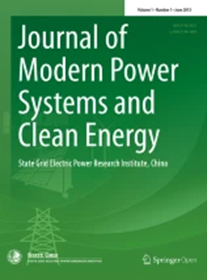考虑台风引起的风电场切断和电网孤岛事件的频率约束机组承诺
IF 5.7
1区 工程技术
Q1 ENGINEERING, ELECTRICAL & ELECTRONIC
Journal of Modern Power Systems and Clean Energy
Pub Date : 2024-06-11
DOI:10.35833/MPCE.2024.000067
引用次数: 0
摘要
在中国沿海地区,海上风电场的扩张刺激了广泛的研究,以降低风电高渗透率电力系统的运营成本。然而,频繁出现的台风等极端天气对系统的稳定性和安全性构成了重大挑战。以往的研究集中研究了由台风断层引起的稳态运行,对这种断层固有的瞬态频率动力学的重视有限。为了解决这一挑战,本文提出了一个频率约束的单元承诺模型,可以促进能源利用和提高弹性。该模型通过台风模拟分析了输电线路故障和海上风力发电带来的不确定性。揭示了台风引起的风电场切断和电网孤岛事件引起的两类电力干扰。此外,考虑到电力系统拓扑结构的变化,定义了新的频率约束。在此基础上,采用分段线性化的方法,将复频率下限约束纳入两阶段随机单元承诺模型。最后,通过数值实验验证了所提模型的有效性,结果表明所提模型能有效提高系统在台风作用下的弹性,改善故障扰动后的频率动态特性。本文章由计算机程序翻译,如有差异,请以英文原文为准。
Frequency-Constrained Unit Commitment Considering Typhoon-Induced Wind Farm Cutoff and Grid Islanding Events
In coastal regions of China, offshore wind farm expansion has spurred extensive research to reduce operational costs in power systems with high penetration of wind power. However, frequent extreme weather conditions such as typhoons pose substantial challenges to system stability and security. Previous research has intensively examined the steady-state operations arising from typhoon-induced faults, with a limited emphasis on the transient frequency dynamics inherent to such faults. To address this challenge, this paper proposes a frequency-constrained unit commitment model that can promote energy utilization and improve resilience. The proposed model analyzes uncertainties stemming from transmission line failures and offshore wind generation through typhoon simulations. Two types of power disturbances resulting from typhoon-induced wind farm cutoff and grid islanding events are revealed. In addition, new frequency constraints are defined considering the changes in the topology of the power system. Further, the complex frequency nadir constraints are incorporated into a two-stage stochastic unit commitment model using the piece-wise linearization. Finally, the proposed model is verified by numerical experiments, and the results demonstrate that the proposed model can effectively enhance system resilience under typhoons and improve frequency dynamic characteristics following fault disturbances.
求助全文
通过发布文献求助,成功后即可免费获取论文全文。
去求助
来源期刊

Journal of Modern Power Systems and Clean Energy
ENGINEERING, ELECTRICAL & ELECTRONIC-
CiteScore
12.30
自引率
14.30%
发文量
97
审稿时长
13 weeks
期刊介绍:
Journal of Modern Power Systems and Clean Energy (MPCE), commencing from June, 2013, is a newly established, peer-reviewed and quarterly published journal in English. It is the first international power engineering journal originated in mainland China. MPCE publishes original papers, short letters and review articles in the field of modern power systems with focus on smart grid technology and renewable energy integration, etc.
 求助内容:
求助内容: 应助结果提醒方式:
应助结果提醒方式:


